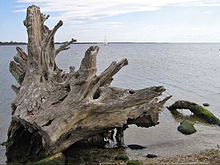Gippsland lakes
| Gippsland lakes | ||
|---|---|---|

|
||
| Landsat-7 image of the Gippsland lakes. Lakes Entrance can be seen in the top right of the photo. | ||
| Geographical location | eastern Gippsland | |
| Tributaries | Avon River , Thomson River , Latrobe River , Mitchell River , Nicholson River , Tambo River . | |
| Drain | short channel to Bass Street | |
| Data | ||
| Coordinates | 38 ° 0 ′ 0 ″ S , 147 ° 39 ′ 0 ″ E | |
|
|
||
| Altitude above sea level | 1 m | |

The Gippsland Lakes are a network of lakes and lagoons in the east of Gippsland in the Australian state of Victoria . The largest of them are called Lake Wellington (in the Aboriginal language Gunai : Murla), Lake King and Lake Victoria . Its tributaries are the Avon River , Thomson River , Latrobe River , Mitchell River , Nicholson River, and Tambo River .
Emergence
The lakes were created by two basic processes: The first is the deposition of alluvial sediment from the feeding rivers. The silt deposited in this way forms narrow sandbanks that can extend for miles into a lake, such as B. that of the Mitchell River in Lake King. The second process is the current in Bass Strait that created Ninety Mile Beach , separating the river deltas from the open sea.
When the lakes were separated from the sea, a new cycle began in which the water level in the lakes rose slowly through the tributaries until the water broke the barrier of Ninety Mile Beach and the water level fell back to sea level. Then the barrier closed again and the cycle began again. Sometimes it takes many years to create a new canal to the sea and it does not necessarily lie in the same place as the previous one.
In 1890 a wall was erected that fixed this natural channel between the lakes and the open sea at a specific point, Lakes Entrance , stabilized the water level in the lakes, created a harbor for fishing boats and allowed boat traffic on the lakes. This canal has to be dredged regularly to prevent it from silting up again, becoming too shallow for ocean-going vessels and starting the processes described above again.
Natural space
The Gippsland Lakes are home to many wildlife and there are two national parks, The Lakes National Park and the Gippsland Lakes Coastal Park . The wetlands at the Gippsland Lakes are protected by the international Ramsar Convention for Wetlands. They provide a habitat for around 20,000 sea birds, including those that come as far as Siberia or the North Pole . There are around 400 native plant species and 300 animal species there. Three plant species - two of them orchids - are also on the red list of threatened species, as are two species of birds, the regent honeyeater and the swallow-tailed parakeet .
Individual lakes
The Gippsland Lakes consist of the following individual lakes:
| Surname | size | location | shape |
|---|---|---|---|
| Lake Coleman | 13 km² | in the very southwest | sickle-shaped |
| Lake King | 44 km² | in the northeast at Bairnsdale | trapezoidal, with several bays |
| Lake Reeve | 52 km² | along Ninety Mile Beach | elongated and very narrow |
| Lake Tyers | 9.5 km² | all the way to the northeast | V open to the north |
| Lake Victoria | 150 km² | in the middle of the lake district | elongated, with bays in the southwest |
| Lake Wellington | 150 km² | in the southwest | oval |
gallery
Web links
- Gippsland Lakes Coastal Park
- Gippsland Coastal Board (English)
- Maps of The Lakes National Park and Gippsland Lakes Coastal Park
- Port Authority of Gippsland (English)
Individual evidence
- ↑ Vaughan Nikitin: Wurruk . ChaosFilter.com Online Publishing (A story in the Aboriginal language Gunai) ( Memento of the original from October 8, 2007 in the Internet Archive ) Info: The archive link was inserted automatically and has not yet been checked. Please check the original and archive link according to the instructions and then remove this notice.


